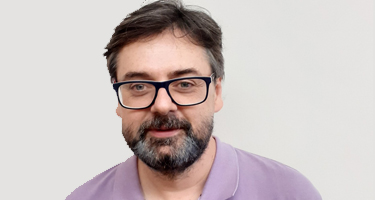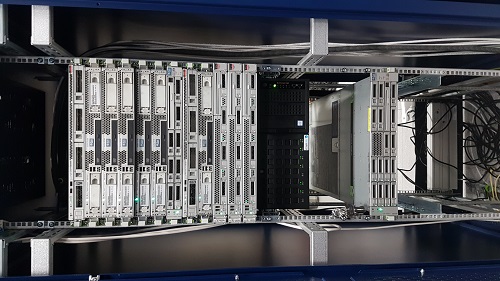
Maciej Paszynski
Full Professor of Computer Science
Ph.D. in Mathematics with Applications to Computer Science
h-index: 21 (Web of Science) 26 (Google Scholar)
Erdös number: 4 (Paszynski -> Andrew Lenharth -> Richard E. Ladner -> Laszlo Lovasz)
Phone: 48-12-328-3314
Email: maciej dot paszynski at agh dot edu dot pl
ORCID: 0000-0001-7766-6052
ResearcherID: H-8883-2012
Scopus: 23393712700
Address:
Department of Computer Science
Faculty of Computer Science, Electronics and Telecommunication
ul.Kawiory 21 Building D-17 Office 2.23
AGH University of Science and Technology
30-059 Krakow Poland
AGH TED Talk (in Polish) (Przydatne symulacje komputerowe: smog, pandemia, powodzie i
nowotwory)
Introduction to simulations (in Polish) (Malopolska Noc
Naukowcow 2020)
Every year, since 2003, I visit
Oden Institute (rank #1 in the world), The
University of
Texas at Austin, USA mostly under JTOden Research Faculty
Fellowship program

I am a full professor at Department of Computer Science, AGH University, Krakow, Poland. I obtained my PhD in Mathematics with Applications to Computer Science from Jagiellonian
University, and my Habilitation in Computer Science from AGH University
of Science and Technology. With my research group "Adaptive Algorithms and
Systems (A2S)" we perform research oriented towards the applications
of artificial intelligence (AI) and high-performance computing (HPC) in advanced simulations.
I am a precursor in Poland of modern computer simulation methods called
isogeometric analysis .
I started researching these methods in 2011 while working in an international team to determine the cost of making such simulations. It turned out
then that the computer simulation methods used require very long computation times on large computers from supercomputing centers to obtain accurate
simulations. Additionally, they require problem specific stabilization methods to obtain reliable simulation results.
In the field of isogeometric analysis, I discovered a new, automatically stable, low-cost way to perform challenging computer simulations on a
regular laptop, without the
use of costly and sometimes hard-to-reach supercomputing centers.
When selecting research topics for my projects, I took into account the benefits for society in line with ethical values.
My Ph.D.
students
I am an Editor of Journal of Computational Science (Elsevier)
I am the thematic
track chair of the
International Conference on Computational Science (CORE A)
Since 2010, I co-chair the Artificial Intelligence and High-Performance Computing for Advanced Simulations
Workshop
Most important recent papers:
Augmenting MRI scan data with real-time predictions of glioblastoma brain tumor evolution using exponential time integrators(How
to simulate brain tumor on MRI scans in a real time)
Robust
Physics-Informed
Neural Networks (how to design loss function for PINN so it coincides with the true error)
Fast parallel IGA-ADS solver for time-dependent Maxwell's equations (super fast solver for 3D electromagnetic
waves
propagation problems)
Robust Variational
Physics-Informed
Neural Networks (mathematical theory and numerical examples showing
how to construct robust convergent VPINNs)
Quasi-optimal hp-finite element
refinements towards
singularities via deep neural network prediction (neural networks selecting optimal hp refinements in 3D
finite element method)
The
first scientiffic evidence for the hail cannon (how to stop a
hail storm)
Influence of Activation Functions on the Convergence of Physics-Informed
Neural Networks for 1D Wave Equation (sigmoid is the best activation function for PINN)
A Kronecker product linear-cost solver for the high-order generalized-α
method for
multi-dimensional hyperbolic systems (a good
preconditioner
to speedup e.g. tsunami simulations)
Automatic stabilization of finite-element simulations using neural
networks and hierarchical matrices (neural networks and
hierarchical matrices for automatic stabilization of challenging PDEs)
Cloud-native
alternating directions solver for isogeometric analysis (how to perform IGA simulations
in clouds)
Stability of non-linear flow in heterogeneous porous media
simulations using higher order and continuity basis functions(Oil extraction simulations)
Graph-grammar
based algorithm for asteroid tsunami simulations (impact of asteroid
tsunami)
Fast Isogeometric Analysis Simulations of a Process of Air Pollution Removal by Artificially Generated
Shock
Waves (a remedy to the air pollution in Krakow)
Tunning three-dimensional tumor progression simulations on a cluster of GPGPUs (Computational
oncology)
Supermodeling, a convergent data assimilation
meta-procedure used in simulation of tumor progression (Computational oncology) [arxiv]
Deep Learning Driven Self-adaptive Hp Finite Element Method (Deep Neural Networks and adaptive
Finite Element Method)
My recent paper has been recognized by Springer Nature, as important research contribution
related to COVID-19 airborn pathogen spread
The mentioned above recognition has motivated this paper
Parallel graph-grammar-based algorithm for the longest-edge refinement of triangular meshes and
the pollution simulations in Lesser Poland area (Pollution propagation simulations)
DGIRM Discontinuous Galerkin based isogeometric residual
minimization for the Stokes problem (Automatic stabilization of flow simulations)
Isogeometric residual minimization (iGRM) for non-stationary Stokes
and Navier-Stokes problems (Automatic stabilization of flow simulations)
Isogeometric Residual Minimization Method (iGRM) with direction splitting preconditioner for stationary
advection-dominated diffusion problems (Automatic stabilization of pollution simulations)
A Massively Parallel Algorithm for the Three-Dimensional Navier-Stokes-Boussinesq Simulations of the
Atmospheric Phenomena (Prototype of the code for simulation of atmospheric phenomena related to climate change)
Application of fast isogeometric L2 projection solver for tumor
growth simulations (Computational oncology)
Fast isogeometric solvers for hyperbolic wave propagation problems
(Possible applications to seismic simulations)
Isogeometric analysis with piece-wise constant test functions (How to speed-up numerical simulations)
Parallel
splitting solvers for the isogeometric analysis of the Cahn-Hilliard
equation (Computational oncology)
Fast and Green Parallel Isogeometric Analysis Computations for Multi-objective Optimization of Liquid Fossil Fuel Reserve
Exploitation with Minimal Groundwater Contamination (Environmental aspects of oil extraction process)
isogeometric Residual Minimization Method (iGRM) with direction splitting for non-stationary advection-diffusion
problems (Automatic stabilization of pollution simulations)
Parallel
fast isogeometric L2 projection solver with GALOIS system for 3D tumor
growth simulations (Computational oncology)
Object-oriented
implementation of the alternating directions implicit solver for
isogeometric analysis (Protype of the code for flood simulations)
Parallel
refined isogeometric analysis in 3D (How to speed up numerical simulations)
Recent projects:
Real-time inversion using self-explainable deep learning driven by expert knowledge IN-DEEP ( Horizon Europe research
and innovation programme under the Marie Sklodowska-Curie grant agreement No 101119556)
Multiscale Inversion of Porous Rock Physics using High-Performance Simulators: Bridging the Gap between Mathematics and
Geophysics MATHROCKS (EU H2020)
Fast isogeometric
finite element method solver as a key component in supermodeling of cancer proliferation (National Science Centre)
New computational paradigm Isogeometric Residual Minimization method (iGRM) and its application for
solution of parabolic, hyperbolic, linear and nonlinear problems (National Science Centre)
IGA-ADS
code with installation and usage manual

ATARI cluster constructed from my National Science Centre, Poland
and Foundation for Polish Science grants
(11 computing nodes, 136 cores total, 210GB RAM total)
Administrated by outstanding Dr Maciej Wozniak (macwozni@agh.edu.pl)
Selected
papers
to download
Teaching
Maciej Paszynski
Graph-grammar
driven parallel adaptive PDE solvers (Habilitation Thesis 2010)
Movies:
Propagation of pollution by the wind over south of Poland (and how Slovakia
is
protected by Tatra
mountains)
Hitting a jelly (alternating direction solver)
Tumor growth (alternating direction solver)
Phase sepparation (material science applications)
Pumping CO2 into geological formations (alternating direction solver)
Selected talks:
Simulations of atmospheric phenomena with different solvers, Basque Center for
Applied Mathematics (invited talk) July
24, 2023
Deep neural networks and smooth approximations of PDEs, Higher Order
Finite Element and Isogeometric Methods (HOFEIM 2023) (invited talk), June 2023
Parallel linear computational cost isogeometric
alternating-directions (IGA-ADS) simulator of time-dependent Maxwell equations, Oden Institute for Computational Engineering Sciences, The University of Texas at Austin,
USA (invited in person talk) July 28, 2022
Parallel linear computational cost isogeometric
alternating-directions (IGA-ADS) simulator of three-dimensional non-stationary problems, Cornegie
Mellon University, Pittsburg, Pennsylvania, USA (invited in person talk) July 19, 2022
Isogeometric Residual Minimization Method for non-stationary Maxwell
problem, Online talk at US National Congress on Computational Mechanics, Chicago, USA, 27 July 2021
"Deep neural network driven self-adaptive hp finite element method"
May 26, 2021, invited online talk at Lawrence Livermore National
Laboratory,
USA
"Deep neural network driven self-adaptive hp finite element method"
April 30, 2021, invited online talk at Ponitifical
Catholic University of Valparaiso, Chile
Slides of talk "DNN-driven self-adaptive hp-FEM"
Isogeometric Residual Minimization Method: a linear computational cost automatically
stable solver for difficult time-dependent problems on tensor product grids, Oden Institute for Computational and Engineering Sciences, The
University of Texas at Austin, USA (invited talk) March 11, 2021
Parallel
alternating-directions linear computational cost direct solver for isogeometric residual minimization method, talk recorded for World
Congress on Computational Mechanics, Paris, January 11-15, 2021
Supermodeling of a tumor dynamics employing isogeometric analysis solvers with piece-wise constant
test functions, Texas A&M, USA, 19 February 2020
Graph
grammar for unstructured mesh refinements, Invited Talk at Distributed Systems Group of Prof. Keshav Pingali, Oden
Institute, The University of Texas at Austin, USA, 9 August 2019
Supermodeling of a tumor with
isogeometric analysis solvers, Invited Talk at Oden Institute, The University of Texas at Austin, USA, 6 August 2019
Slides for Oden Institute talk
isogeometric Residual
Minimizaton Method (iGRM), Invited Talk at INRIA, Paris, 27 May 2019
Slides for INRIA talk
isogeometric Residual Minimizaton Method (iGRM), Invited Talk at University of Valparaiso, Chile, March 8, 2019
isogeometric Residual Minimization Method (iGRM), Invited Talk at University of Alberta, Edmonton, Canada, August 18, 2018
isogeometric Residual Minimization Method (iGRM), Invited Talk at Symposium in Honor of Prof. T.J.R. Hughes, World Congress of Computational Mechanics, New York, July 2018
Fast
and smooth simulations of time-dependent problems, Curtin University,
Perth, Australia, November 22, 2017
Fast and smooth simulation of space-time problems, Short course at Intituto de
Matematics, Pontificia Universidad Catolica de Valparaiso, Chile, July 24-28, 2017
Fast isogeometric finite element method solver for melanoma tumor growth simulations, Invited Talk at University of Rio de Janerio, Brasil, June 7, 2017
Fast isogeometric finite element method solver for melanoma tumor growth
simulations, Invited Talk at LNCC, Petropolis, Brasil, June 1, 2017
Fast isogeometric finite element method solver for melanoma tumor growth simulations, Invited Talk at Center for Computational Oncology, The University of Texas at Austin,
Texas, USA, April 26, 2017
Fast isogeometric finite element method solver for melanoma tumor growth simulations, Texas A&M University,
College Station, Texas, USA, April 19, 2017
Application of fast isogeometric L2 projection solver for tumor growth simulations, Invited Talk at SIANI, The University of Las Palmas
de Gran Canaria, March 21, 2017
Fast isogeometric finite element method simulations
of melanoma tumor growth, Invited Talk at Basque Center for Applied Mathematics, Bilbao, Spain, February 14, 2017
Parallel Direct Solvers for Isogeometric Finite Element Method,
Invited Talk at LNCC, Petropolis, Brasil, December 5, 2016
Tumor growth simulation using isogeometric L^2-projections solver, Invited Talk at ICES, The University of Texas at Austin, 30 August 2016
Parallel Matrix Algorithms and Applications 2016, Bordeaux, France
Invited talk at HOFEIM, 2016, Jerusalem, Israel
ICCS 2016 Talk, San Diego, CA, USA
Invited talk at Fourth International Congress on Multiphysics, Multiscale, and Optimization Problems,
May
26-27, 2016, BCAM, Bilbao, Spain
Invited talk at BCAM, Bilbao, Spain,
2016
Slides for BCAM talk
Visit
at
Valparaiso, Chile, 2015
Visit at ICES,
The University of Texas at Austin, 2014
Visit at ICES, The University of Texas
at Austin,
2014
Visit at ICES, The University of Texas
at Austin,
2013
Visit at
ICES, The University of Texas at Austin, 2012
Visit
at BCAM, Bilbao, Spain, 2014
Visit at
KAUST, Saudi Arabia, 2014
I traveled 108,000 kilometers in 2017 and around 1,000,000
kilometers since 2003


